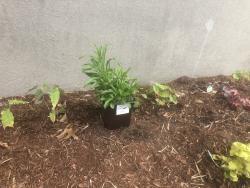Greetings and hoping this finds all Safe, Healthy, and Happy; especially during this world wide pandemic (4/2020).
I am planting a garden filled with all wildflowers found in the woodlands, mountains, forests, along side river beds and creeks of the fascinating state of CT.
This is somewhat new to me as I usually grow only things one can eat. However, some are at least familiar to me as I was born and raised in Washington, D.C.and I have seen a few during my hikes along the Appalachian Trail, Annapolis and the Severn River, along the Chesapeake Bay, etc...
I have a Campanula persicifolia 'La Bonne Amie' that I purchased late last year (~10/19) and it overwintered on my outside patio. It is true that it is a perennial and survived just fine with no intervention save but the autumn and winter outside arena in planting Zone 6b.
It is now and it is 4/20. Plant looks grest and ready to transplant from 5 pint container to in-ground back yard.
•Leaves are a beautiful emerald green and are homogenous throughout.
The are elongated, well-balanced lance and tapered from close to plant stem is thin - wide - thin (toward tip of leaves)
•No flowers yet but should not be long and will keep you informed.
Sincerely, DrCarla in Stamford, CT

